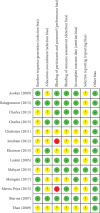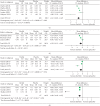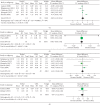Effects of Herbal Mouthwashes on Plaque and Inflammation Control for Patients with Gingivitis: A Systematic Review and Meta-Analysis of Randomised Controlled Trials
- PMID: 32419797
- PMCID: PMC7201456
- DOI: 10.1155/2020/2829854
Effects of Herbal Mouthwashes on Plaque and Inflammation Control for Patients with Gingivitis: A Systematic Review and Meta-Analysis of Randomised Controlled Trials
Abstract
Objective: The aim of this study was to evaluate the overall effects of herbal mouthwashes as supplements to daily oral hygiene on plaque and inflammation control compared with placebos and chlorhexidine (CHX) mouthwashes in the treatment of gingivitis.
Methods: PubMed, EMBASE, Cochrane Database of Systematic Reviews, Cochrane Central Register of Controlled Trials, and grey literature databases were searched. Only randomised controlled trials (RCTs) comparing herbal mouthwashes with placebos or CHX in the daily oral hygiene of patient with gingivitis were included to compare the effect of different mouthwashes on plaque and inflammation control.
Results: A total of 13 studies satisfied the eligibility criteria, and 11 studies were included in meta-analyses. Significant differences were observed in favour of herbal mouthwashes compared with placebos in both plaque- and inflammation-related indices (Quigley-Hein Plaque Index, QHPI: WMD = -0.61, 95% CI (-0.80, -0.42), P < 0.001; Gingival Index, GI: -0.28 (-0.51, -0.06), P=0.01; Modified Gingival Index, MGI: -0.59 (-1.08, -0.11), P=0.02; Gingival Bleeding Index, GBI: -0.06 (-0.09, -0.04), P < 0.001). No significant difference was found between herbal and CHX mouthwashes.
Conclusions: Herbal mouthwashes have potential benefits in plaque and inflammation control as supplements to the daily oral hygiene of patients with gingivitis. Although no difference was observed between herbal and CHX mouthwashes in the selected studies, further high-quality RCTs are needed for more firm support before advising patients with gingivitis about whether they can use herbal mouthwashes to substitute for CHX mouthwashes or not (PROSPERO registration number: CRD42019122841).
Copyright © 2020 He Cai et al.
Conflict of interest statement
The authors declare that there are no conflicts of interest in this study.
Figures




References
-
- Rodan R., Khlaifat F., Smadi L., Azab R., Abdalmohdi A. Prevalence and severity of gingivitis in school students aged 6–11 years in Tafelah Governorate, South Jordan: results of the survey executed by National Woman’s Health Care Center. BMC Research Notes. 2015;8(1):p. 662. doi: 10.1186/s13104-015-1532-y. - DOI - PMC - PubMed
Publication types
LinkOut - more resources
Full Text Sources

